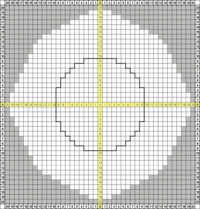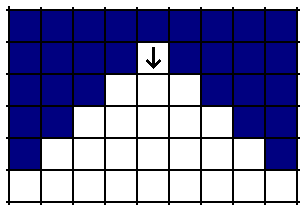Line of sight
All units, both X-Com and alien, have a line of sight. A unit's line of sight encompasses any objects or other units which are:
- Within visible range
- Visible range for X-Com soldiers is 20 tiles during the day and dawn/dusk, 9 at night
- Aliens are not subject to the lighting penalties and have a 20-tile range at all times
- Not blocked by terrain, smoke, or other units
- Within the unit's field of vision
All units have a 90 degree field of vision, radiating outward in a cone in whichever direction they are facing.
Note that line of fire is not necessarily the same as line of sight. There are cases where you can shoot around objects (such as corners) that you cannot see around, and you can always shoot beyond the 20-square visual range (see Sniper Tactics). You can also shoot through smoke that you can't necessarily see through.
Also note that you can't see aliens right next to you when you first go through a door. To see adjacent aliens, you will need to turn twice to check your flanks: one facing (45 degrees) to the left, then two facings (90 degrees) to the right (or vice-versa). This will allow you to scan a whole room upon entry, obstacles notwithstanding. Thankfully, turning in place does not trigger reaction fire.
Visual range

The visual-range map is "rounded" and decreases by 2 tiles in one dimension for every 1 tile in the other dimension, until it reaches the pure diagonal (see inset map). You may want to have soldiers e.g. just outside visual range of a UFO exit, so that enemies have used a chunk of their TUs before they see you (the better to reaction fire). Anyone directly lateral to the exit (no diagonal offset) should be at range 20, but others (with diagonal offset) should be "closer". For example: An offset of 19 tiles in one dimension (e.g. north-south) and 1 tile in the other (e.g. east-west) is also just outside the "20" visual range. Using this can help you have multiple shooters able to reaction-shoot to a particular tile at the same time - aliens are liable to stop and shoot as soon as they see even one soldier.
Elevation does not add distance to visual range. You will see an alien on the ground when at range 20 (horizontally) and elevated 4 levels, just as you'd see him at range 20 when at ground level. Keep this in mind if stacking flying-suit shooters vertically in "alley" situations (or any other time, for that matter). But beware overhangs that might block your LOS.
Note that "visual range of 20" is for sighting enemies, the most important thing in X-COM. Terrain works slightly different. Specifically: At ground level, you see terrain to 21 tiles away, not 20 (counting from your tile as 0, as was demonstrated in inset for sighting enemies). Also, if you are elevated, the range increases by one for each level, up to 24 tiles away for 4th level. Yet this is only for terrain. You will not see enemies past 20 tiles, as explained above. It can still be useful to know, however. You may think you've visualized the whole map out to the edge, but actually you didn't sweep the last few edge tiles if you were flying high and stopping as soon as you could see all the way to the edge. Then again, it's unlikely that an alien was there and/or didn't wander into view around the time you're checking it out. An exception exists with several arctic map tilesets, where puddles have the potential to trap non-flying aliens in the corner of the map.
Quirks
There are cases where aliens can see around corners (and shoot at you) when you cannot see them. This phenomenon is not fully understood at this time. [Need diagrams of LOS around corners/beyond roofs.]
In certain cases, it is possible to see into a UFO from the outside (see External UFO Windows).

